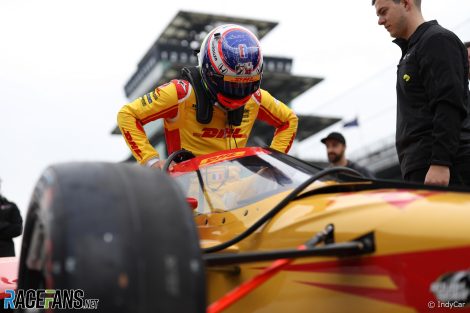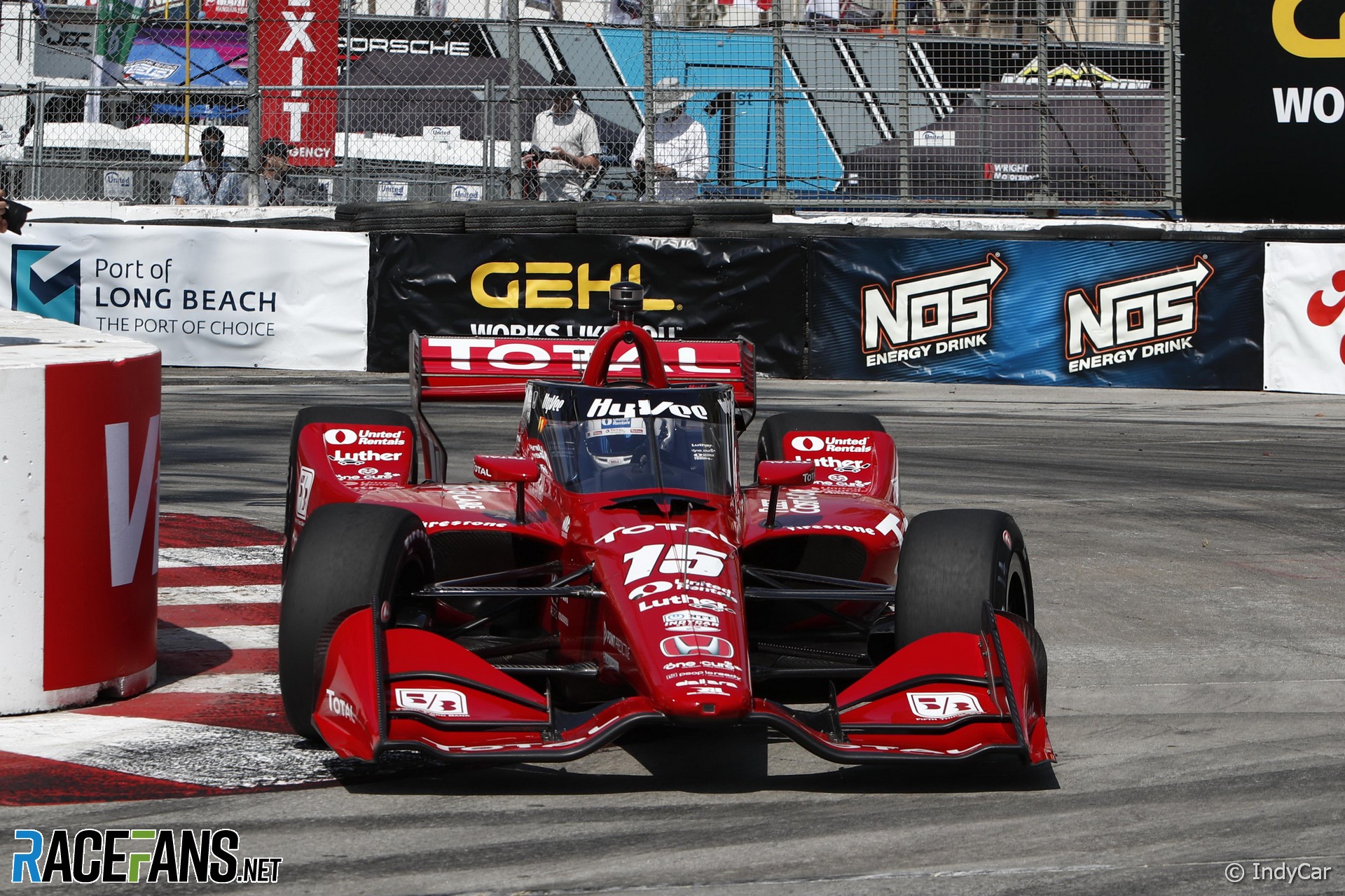Several IndyCar drivers have urged the series to slash the weight of its chassis when it replaces the current DW12 after next season.
The DW12 weighs a maximum of 771kg in road and street course specification, excluding the fuel, driver and drink. Its weight is set to rise in 2023 when the series introduces new power units including hybrid systems that will increase their power by around 200bhp.However, several of the series’ more experienced drivers have urged the category to reverse the car’s recent weight gains. Among them are Will Power, Scott Dixon and Graham Rahal, who have over 800 starts in IndyCar and the former Champ Car series between them.
“I think the car is too heavy,” said Power yesterday. “I think once they add that hybrid thing, it’s just too much. It already was with the windscreen but it’s become less and less nimble. They’ve got to find a way to lose some weight out of the car.”
Dixon described the current IndyCar as “more of a junior category car” in its performance. “It’s not particularly fast, it’s not particularly nimble, it’s very heavy, there’s not a whole lot of grip and some of the circuits that we go to are very low-grip as well.”
The six-times champion said the changes to the current car since its introduction a decade ago, such as the addition of the Aeroscreen, have been necessary on safety grounds and comparable to weight rises in other categories, such as Formula 1.
“[The] car has basically just changed but I think the reason for some of the weight gains have been huge safety situations such as the Aeroscreen and things like that which, those are no-brainers. And I think you’re seeing a lot of formulas kind of going down that road at the moment just in the way that the technology is shifting.
Advert | Become a RaceFans supporter and
“We’re maybe not as quick, I’d say, maybe on chassis development or upgrading, we’ve had the same car since 2012. That will change in due course but the big focus right now is the introduction of the hybrid system, new engines from the manufacturers and those are big shifts.

However, Dixon is concerned the increased weight of the car could itself become a safety concern.
“The weight thing is probably something that’s at the forefront because the cars are getting heavy and I think that becomes a safety issue at some point just because the speeds are staying pretty similar. But I think the counter-sides that we’ve had of introducing the safety implements have been far outweighing [that].
“The series is always working extremely hard to make the sport better and the competition better. I don’t think there’s any formula in the world that is as competitive as what we have in IndyCar right now and they’re making it better. So it’s all on the right road and there will be some things that they correct in the next few years as well.”
Graham Rahal pointed out that the current IndyCar had also become increasingly heavy over time because of other additions made to the car following its introduction. He said these changes must be avoided with the DW12’s successor.
Advert | Become a RaceFans supporter and
“On the next IndyCar the focus must be, must be, to build the car right in the first place,” he said. “We built this chassis in 2012, it wasn’t quite there so we had to add [anti] intrusion panels, we had to add stiffeners – if you remember one cracked on J-Wil [Justin Wilson] I think at Fontana. Sebastien [Bourdais] had his issues. So we had to add stiffeners and this and that.
“So the weight of the car is significantly higher than when I started my career. Now you’re adding in the hybrid engine and everything else, significantly higher [weight]. Obviously the Aeroscreen, another massive [part]. It’s not a knock on where we’re at but it is a key focus going forward to the next generation of the car. We need to drop the actual chassis weight down significantly.”
Dallara recently extended its contract to be the sole supplier of IndyCar chassis. Rahal says he has complete confidence in their ability to produce a suitable design.
“It’s just important I think that we get the car the built right the first time around. We’ve learned a lot. I have all the faith in the world in Dallara, they’ve always kept me safe, they’ve done a great job. But I think it’s really important.”
IndyCar
- F2 champion Pourchaire to make IndyCar debut for McLaren at Long Beach
- IndyCar’s packed pit lanes “a good problem to have” with 29-car field
- How to watch the Chinese GP, IndyCar at Long Beach and WEC at Imola
- Prema announce move into IndyCar with new two-car team in 2025
- Palou dominates IndyCar’s Thermal Club $1 Million Challenge





Roth Man (@rdotquestionmark)
19th January 2022, 11:52
Not sure there’s much they can do to lighten the cars with the way the hybrid transition is coming. Maybe try and counter the additional weight and power with more ground effect and if possible some more mechanical grip through the tyres.
BasCB (@bascb)
19th January 2022, 13:15
I think what Graham Rahal mentions about the car being added to over time with several “repairs” of flaws, then safety measures (anti intrusion, aeroscreen) and now with the hybrid engines should on the other hand offer plenty of opportunity to make a lighter chassis if they design it new from the ground up @rdotquestionmark
Proesterchen (@proesterchen)
19th January 2022, 15:15
This being Indycar, though, they will never have another ground-up design unless Roger Penske gets tired of the current tub and heavily subsidizes its replacement to all the grifters in the pitlane.
bosyber (@bosyber)
19th January 2022, 16:11
Heh, I completely agree with @bascb, but indeed in reality that’s probably a good point too @proesterchen
Radoye
19th January 2022, 16:36
That’s what is in the plans actually, a completely new ground-up chassis design from 2024 or 2025. See here:
https://racer.com/2021/09/25/planning-process-in-motion-for-next-generation-indycar-chassis/
(I apologize if linking to other news sites is not allowed, feel free to remove the link)
BasCB (@bascb)
20th January 2022, 8:06
Thanks for adding that Radoye, you are right there, adding links is perfectly fine (provided they are on point).
As this post shows, the reason drivers bring up this, is exactly because they KNOW that there is a newly designed car in the works and chip in to push for a good approach.
petebaldwin (@)
19th January 2022, 11:57
“It’s not particularly fast, it’s not particularly nimble, it’s very heavy, there’s not a whole lot of grip”
I thought I was reading an interview with Toto for a second there….
MacLeod (@macleod)
19th January 2022, 13:16
I thought they were talking about F1 cars……
BasCB (@bascb)
19th January 2022, 13:18
Yeah, pretty much about exactly the same things between F1 and Indycar, right (and also happening to road cars by and large) with more complicated powertrains, batteries and for electric/hybrid energy and more and more safety features, sensory systems etc being added @petebaldwin
José Abreu (@jabr)
19th January 2022, 23:36
Well, F1 cars may be heavy, less nimble than in the past and sometimes lack grip, but they ARE fast.
Proesterchen (@proesterchen)
20th January 2022, 15:14
+1
Aaron
19th January 2022, 12:24
Meanwhile F1 doing their best to have 1 ton cars in a few years
Sensord4notbeingafanboi (@peartree)
19th January 2022, 13:19
Great that Dixon points out that weight is a safety concern.
Don
19th January 2022, 15:18
This is obviously a problem for all racing series as they try to improve safety. Increasing safety components add weight, but the addition of the aeroscreen added a HUGE amount of weight, in the worst possible place up high on the car. This will certainly be corrected with the next chassis.
amian
19th January 2022, 16:35
I would love to see a weight change graph for the Dallara chassis 2012-2022.
Those custom aero appendages that covered the rear wheels until 2017 must’ve been heavy, so they at least got rid of those.
What’s quite interesting is that on oval tracks like Indy here the pace has been stable:
[Yea]r – [fastest Indy 500 race lap in mph]
2012 – 220.1
2013 – 226.9
2014 – 225.1
2015 – 226.7
2016 – 225.2
2017 – 226.1
2018 – 224.1
2019 – 226.0
2020 – 223.1
2021 – 227.3
Bobson Dugnutt
20th January 2022, 13:27
Well, when you’re running de facto top speed on full throttle the entire lap, the weight doesn’t matter as much as when the car has to repeatedly brake/accelerate/corner
amian
20th January 2022, 18:31
You’re right indeed. If you hit the rev limiter, it doesn’t matter what force you had to exert to hit it.
Fer no.65 (@fer-no65)
19th January 2022, 18:15
This is an issue in every motorsport series, basically, plus road cars… 200 bhp more in a car that’s heavy isn’t going to fix anything, or rather is going to create more problems
mmertens (@mmertens)
20th January 2022, 13:01
This is the conundrum all racing series are facing with the shift to hybridization on PUs. The more they go towards hybrid systems the more weight is added. It’s now getting towards 1 Ton already. Makes me wonder if this is really the way to go. Sometimes it feels there’s a place or a niche for a new series in motorsport. If someone could produce carbon fibre car with a simpler 4 or 6 cylinder turbo engine reaching 800bhp, within 600kg, it would make for an interesting series to watch.
anon
20th January 2022, 18:29
@mmertens increased standardisation and increased durability requirements to cut costs have, in recent years, been a far more significant contributor to increased car weights.
In F1 in recent years, the additional weight due to hybridisation is actually dwarfed by that due to the addition of other factors. We’ve had additional weight added on due to multiple increases in the weight of the wheels, the introduction of the halo system, the use of standardised crash protection systems and a minimum mass for the driver and their seat – meanwhile, part of the reason for the major increase in weight that is coming up for the new rule set is the significant increase in standardised parts and further increases in the weight of the wheels.
IndyCar also had that issue with the current DW12 – when you look at the original planned weight of the DW12 back in 2011, and then you look at the current regulations, you will note that the final design weight of the DW12 is about 80kg heavier than it was meant to have been.
The imposition of standardised low cost parts was a noticeable factor, and the engine durability requirements that IndyCar imposed also drove the weight up quite markedly too – back in 2011, it was suggested that the engines alone ended up around 30kg heavier due to the combination of engine mileage requirements and the requirement for low cost components manufactured from a limited range of materials, let alone the rest of the chassis.
DaveW (@dmw)
20th January 2022, 14:04
Nothing has happened in vehicle architecture, materials science, or battery chemistry that will allow a radical reduction in mass with similar performance. I have low expectations.
In fact I think that as with road cars the path to range and performance may be with very massive vehicles. If you said 15 years ago that a 5400 lb 2500 kg electric sedan would have super car track times people would laugh.
Proesterchen (@proesterchen)
20th January 2022, 15:15
+1
ryanoceros (@ryanoceros)
23rd January 2022, 19:00
Aeroscreen is a ridiculous solution and should be swapped for halo and ballistic helmets as in F1 and other FIA open wheel series. It’s just too much weight to put so high up in the car, not to mention too much overall weight.